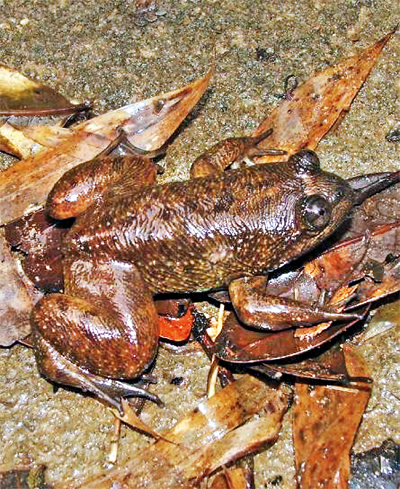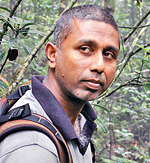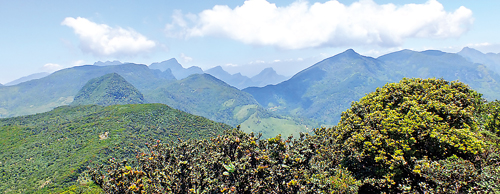A chocolate brown croaking beauty emerges from the mist-covered Knuckles
Long nights and tired days, cold and wet atop the Knuckles Range, braving strong winds, heavy drizzles and thick mists!
The loud croaking of frogs, mainly on rainy nights, nudged them on against the inclement weather, with the quest ending in a new rare species, a chocolate brown beauty, being picked up in the mist-shrouded cloud forests of the Knuckles Range.
 Lankanectes pera is what the fully-local research team has taken from the wet rock crevices to shine a light on, with the findings being published in Zootaxa last month (August) under the title ‘A new frog species from rapidly dwindling cloud forest streams of Sri Lanka’. Zootaxa is a peer-reviewed scientific mega journal for animal taxonomists published by Magnolia Press based in New Zealand.
Lankanectes pera is what the fully-local research team has taken from the wet rock crevices to shine a light on, with the findings being published in Zootaxa last month (August) under the title ‘A new frog species from rapidly dwindling cloud forest streams of Sri Lanka’. Zootaxa is a peer-reviewed scientific mega journal for animal taxonomists published by Magnolia Press based in New Zealand.
Researcher Pradeep Samarawickrama who is currently working as the Environmental Officer for a private company handling World Bank projects explains that the genus Lankanectes is endemic (native or restricted) to Sri Lanka, having the common names Dumbara Wakarali-madiya in Sinhala and Dumbara corrugated frog in English.
Contrasting the common L. corrugatus which occurs in muddy areas including marshes and paddy fields where they burrow into soft mud and leaf litter, he says that the rarer L. pera has so far only been found under more pristine conditions — sand and rock strewn clear-water mountain streams flowing under canopy cover, where they hide in rock crevices.
This ‘niche specialization partitioning’ between the two species can be an important factor that prevents the specialized L. pera from spreading more widely, it is learnt.
Another important factor that needs to be considered is that due to its small area of occupancy and extent of occurrence, along with the small population sizes seen during this study, L. pera can be evaluated as a ‘Critically Endangered’ species, points out Pradeep who also quotes the IUCN Red List.
This would be in contrast to L. corrugatus which has a wide distribution and large population size and is considered a species of ‘Least Concern’.

Shiromi Samarawickrama
L. pera needs immediate conservation attention due to its specialized habitat and requirements and climatic conditions, which are predicted to deteriorate under the current predicted global climatic warming models, stresses Pradeep.
Even though the paper on the new find has been published last month, the tale begins long before as a family affair. The “hint” of a new species of frog came when Pradeep’s wife, Shiromi, embarked on her M.Sc thesis, ‘Herpatofaunal diversity in the Dotulugala Man and Biosphere Reserve of the Knuckles Forest Range, Sri Lanka’ studying amphibians. The Knuckles Range consists of moist tropical or subtropical forests characterized by persistent low-level clouds.
Shiromi and Pradeep and many students from the Peradeniya University, like the team which followed thereafter, camped out in tough terrain after putting up tents, eating frugally and roughing out with basic stuff they could carry in their backpacks.

Pradeep Samarawickrama
Following the hint received from the M.Sc research, they joined forces with a bigger team to establish as a certainty that there was a new and rare species of frog.
The team members in the latest research are Gayani Senevirathne Nayana Wijayathilaka; Kelum Manamendra-Arachchi; Gayan Bowatte; Shiromi Samarawickrama; and Madhava Meegaskumbura, in addition to Pradeep.
The “beauty” of this research like the rare frog that they have discovered, according to Pradeep is that local scientists from across the world networked to bring forth the findings.
Some members of this multidisciplinary team are from the Peradeniya University’s Postgraduate Institute of Science and the Department of Molecular Biology & Biotechnology, Faculty of Science; the Sri Jayewardenepura University’s Department of Zoology, Faculty of Applied Sciences; the Agricultural Ministry’s Land Use Policy Planning Department; the Postgraduate Institute of Archaelogy; and the National Institute of Fundamental Studies, Kandy.

The spectacular Knuckles Range
The others are from the Department of Organismal Biology & Anatomy, University of Chicago, United States of America; Melbourne School of Population and Global Health, University of Melbourne, Australia; and the Guangxi Key Laboratory for Forest Ecology and Conservation, College of Forestry, Guangxi University, Nanning, China.
Of course, in honour of the major contribution by the Peradeniya University, the new species has got as its ‘tail’ pera in apposition.
“We simply could not do it alone,” according to Pradeep. The expert input on genetic studies, sample collection and even the permits from the Forest Department and the Department of Wildlife Conservation came from the other members of the team.
Here too, they roughed out for weeks on end, eating just one meal of rice with dried vegetables, which they cooked on a small petrol cooker and having noodles at all other times. Freeze-dried vegetables which were their staple are easy to carry because they are not heavy, laughs Pradeep, adding that they had “to go light” on food stuff, as they had to lug with them camera equipment.
All for a worthy cause, culminating in finding a new species.
| A plea to protect Knuckles | |
| A strong plea from the heart goes out to the authorities from Pradeep – protect the environment where we find all these fascinating new species. Our research, the result of exhausting work would be futile if the papers gather dust on some shelf or are just online, if we don’t preserve, protect and safeguard the environment, both from human and natural adverse impacts, reiterates Pradeep who is in the forefront of battles to get cinnamon cultivations out of Knuckles. “Like at the Sinharaja Rainforest, we need to have a buffer zone around the Man and Biosphere Reserve at Knuckles,” is his fervent plea. He echoes the concerns expressed in the research paper which is categorical that the Knuckles Range is already highlighted as a mountain refuge for as many as eight micro-endemic frog species that are already considered to be Critically Endangered or Endangered. With the habitat requirements of L. pera being different from that of the highly threatened micro-endemics highlighted so far, the conservation strategy for amphibians of Knuckles “must” consider this new knowledge — the conservation of streams of the mountains, it adds. In his bid to protect sensitive ecosystems which are home to wonderful creatures, Pradeep of gadeya or Green Labeo (Labeo fisheri) fame has been at the forefront of many a campaign. Not only did Pradeep in early 2011 find the critically-endangered gadeya, a freshwater herbivorous fish similar to the carp, in Waratenna-Hakkinda in Kandy, but he also fought long and hard along with other environmentalists to get the area declared an Environmental Protection Area (EPA) in 2017. |
| Focus on two sisters | |
| It is all about grey, white and brown, and several other distinct features that the researchers zeroed in on when comparing and contrasting the two amphibian sisters — Lankanectes pera (the new species) and the other one – Lankanectus corrugatus. While the larger L. pera has a greyish underside without many patches L. corrugates has a whitish underside with prominent brown patches, points out Pradeep, explaining that the new one also has whitish tubercles on the throat which are clearly absent in the other. The research paper describes L. pera as being “dorsally chocolate brown with unequal dark-brown patches. Ridges of the numerous prominent corrugations lighter in colour, with interspersed light-brown spots. A light-brown bar edged with dark brown/black colours in the interorbital area”. L. pera differs from L. corrugatus in all criteria (external morphology, genetics and climatic niche) on which they were evaluated. In morphology, there are several consistent, but somewhat subtle differences between the two species — tubercle distribution and several colour and pattern related features. L. pera is also larger than L. corrugatus, it adds. When taking into account adult frogs of L. pera, the researchers also found that they had very superiorly placed eyes allowing for wide vision. Their teeth pattern on the upper mandibles was also different to L. corrugatus. The habitat is also another major difference, with the rare L. pera restricted to the high altitudes of the Knuckles hills, while L. corrugates is found in wetlands across the country. L. pera is restricted to streams flowing through the montane forests on the highest peaks above 1,200m in the Knuckles Range, the paper states, adding that this species has so far only been observed inhabiting pristine streams flowing through closed-canopy montane forests. Males had been found under rocks or rock-crevices in flowing water. They would occasionally call haltingly during the day, but several males frequently vocalized in chorus at night, especially after light rain, the study states. Focusing on tadpoles, it points out that they are large and occur in deeper regions where decaying vegetation gathers. There seems to be resource partitioning between the adult and tadpole habitats — tadpoles are found in pockets of deeper pools with detritus, while adults prefer rocky and sandy regions. In external morphology, the tadpoles of both L. corrugatus and L. pera were similar. |


